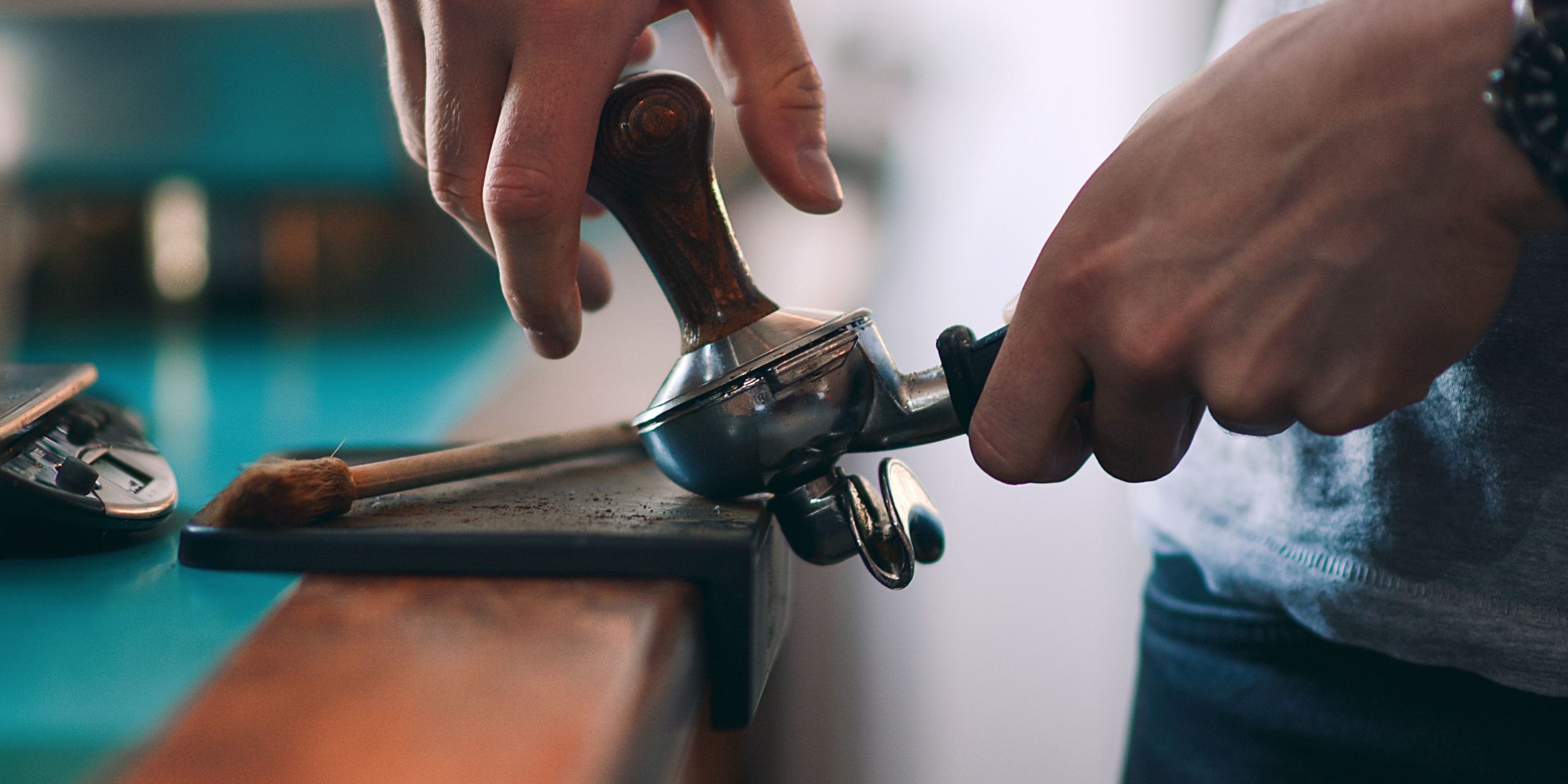Read Time: 7 Minutes |
We discuss how this delicious serve came to be, how to make the espresso tonic and how we’re incorporating iced coffee drinks into our barista course and barista training
| By Cameron Mowat
Our Barista Courses in Dublin are always being improved on, part of that means keeping an eye out for trends that are taking the coffee scene by storm. At the moment the hottest new serve is the Espresso Tonic, an iconic looking iced coffee drink bursting with flavour that will give any of the popular iced coffee styles a run for their money.
As a trend that started in the States and/or in Sweden, it has finally made its way here to the Emerald Isle, so it’s only appropriate that as a provider of Barista courses in Ireland we show you and our students at our bartender and barista school in Dublin how to make the Espresso Tonic!
Hot or Cold?
Most of us think of coffee as a ‘hot drink’ like tea, but in reality there are myriad ways to serve the world’s favourite beverage.
One of the most popular in the modern coffee climate is iced coffee. As summer approaches iced coffee sales spike as it becomes the caffeinated beverage of choice for the warmer days.
Coffee cocktails are also growing in popularity, spurred on by the ever increasing demand for Espresso Martinis across cocktail culture. More and more coffee including cocktails are making it onto menus and the quality of coffee preparation, the origin and the roast are becoming more and more important to the coffee cocktail process.
Coffee expresses its flavours differently when it is served cold. Hot coffee tends to be more acidic and more bitter than its colder counterpart, leading to lighter and more subtle flavours in cold coffee that often let the sweeter and fruitier notes shine through. This may be one of the reasons that less experienced coffee drinkers tend to gravitate towards iced coffee and coffee cocktails.
For baristas it is as important to have a handle on the world of cold coffee drinks as their heated cousins that tend to dominate the spotlight. Whether it’s coffee cocktails, iced coffee or indeed the Espresso Tonic, cold coffee is only going to get more and more popular.
History of Iced Coffee
Iced coffee has several different origin stories, but the widely accepted beginnings is in Algeria in the mid 1800s. There they served a brew called ‘Mazagran’, which was a mixture of coffee syrup and cold water, invented in an effort to give French soldiers some respite from the heat of the day whilst still getting their caffeine fix during the war in the 1840s.
This new concoction followed the soldiers home to France, where it would become served as the ‘café mazagran’. As ice became more ubiquitous around the world so too did the ability to serve coffee cold and keep the drinks colder for longer. Often hotter climates were the places that iced coffee reigned supreme, where refreshing drinks were the name of the game.
Iced coffee drinks would go on to take many different forms around the world over the next 180 years. Almost any way of serving coffee over ice you could think of has been tried out, with a range of serves making it into the modern day.
The most popular style of iced coffee was popularised on an international level by Starbucks in the 1990s, known as the ‘frappé’ or ‘blended’ in French. This is, as it sounds, coffee and milk blended with ice and often including syrups and whipped cream. Now iced coffee is offered in some shape or form in most coffee shops worldwide.
The Coffee Tonic on the other hand is a relatively recent invention, but one that is spreading across the world, likely on the back of the gin boom that popularised quality tonics once again. And of course because the drink is delightfully instagramable.
There are a few cafes that claim to have invented the serve, including Box Kite in New York City and Koppi in Helsingborg, Sweden. Regardless of where it comes from, the sales speak for themselves, with 95% of iced coffee served in Koppi being made up of Espresso Tonics (or Kaffe & Tonic as they call it).
So let’s get into making this serve that’s giving the frappé a run for its money!
How to make the Espresso Tonic
Of course the Espresso Tonic recipe is very simple. It is: ice, tonic and espresso.
The two most important things to note when preparing the Espresso Tonic are: ingredient choice and the method of preparation.
Ingredient choice:
Ice:
Simple right? Wrong! As most bartenders worth their salt will tell you, ice can make or break cold drinks.
Wet, thin or heavily dimpled ice melts very quickly, over diluting the drink faster than it can be consumed and ruining the texture, balance and flavours. We always recommend using thick, square ice with minimum dimples where at all possible. Hoshizaki is our go to, if you can get your hands on it, the stuff lasts for ages. The better the ice the better the drink.
Remember: we’re going to be pouring hot fresh espresso over the ice in this drink which will cause instant melting and dilution, so the more robust the ice, the better the final product.
Tonic:
Not all tonics are created equal. There are vast swathes of tonics out there, from bog-standard to premium. Why settle for anything less than the best when it comes to your Espresso Tonics?
There are also so many different styles to choose from, and preference is everything. However we recommend something without artificial sweeteners and a flavour profile that will match nicely with your espresso’s. We tend to go for the Thomas Henry Dry Tonic, which has bright citrus notes alongside a clean and floral quinine flavour (the active ingredient in tonic).
Espresso:
As the linchpin of this drink, the espresso’s character, from quality to origin, is key.
The first step is of course making perfect espresso by knowing your espresso machine, choosing your bean and balancing the bitterness, acidity and sweetness. The origin and roast of the coffee will have a great impact on the flavours of the Espresso Tonic. Some origins produce more acidic styles, some more floral, with each being impacted heavily by the length and intensity of the roasting process. Different roasts for different folks as they say!
Method:
How we go about making this delicious beverage will of course affect the final product. There is no agreed upon way but let’s just say there are good and bad ways. So let’s get into it.
Step 1: Ice your glass.
Ice the glass all the way to the top. This will maximise the amount of chill in the vessel and each cube will support the other in keeping themselves colder for longer. We always teach this as a primary rule when making drinks on our cocktail courses. If you can also chill your glass beforehand, either with ice or in a fridge or freezer this will also go a long way to keeping the drink fresher for longer.
Step 2: Pour your tonic.
Pick your best and preferred tonic and pour it over the ice. Again if this tonic is already cold you’re on the best track for a great Espresso Tonic. Leave enough wiggle room for both your shot or double shot of espresso and some more room at the top for the foam which will be created as the bubbles from the tonic mix with the crema of the espresso. Then, and this is important, let the tonic chill for a short while in the glass so it gets as cold as possible before meeting the espresso.
Step 3: Pour your espresso.
If your glass will fit directly under the portafilter of your espresso machine then this is the best way to go about it. Run the espresso straight onto the ice and watch as it slowly travels down the ice and meets the tonic, creating a layered effect. If you can’t pour the espresso directly from the machine make sure to pour very slowly from another vessel like a jug to achieve this effect. You should see the layering effect, or if your tonic is very light in sugar content there may be more of a marbling effect as the espresso and tonic intermingle. You should also see a foam forming on the top of the drinks as mentioned previously, consisting of the bubbles from the tonic and the crema from the espresso.
Step 4: Garnish
This drink really needs no garnish, however there are some that really elevate the flavours. You might want to go for something stylish like coffee beans or some sort of powder, however we suggest you use a lemon or orange zest, expressed over the top and either discarded or placed gently to the side of the ice.
And there you have it, you’ve made a perfect Espresso Tonic. Now sit back, sip and enjoy!
Incorporating iced coffee and coffee cocktails into our Barista Course
The Espresso Tonic is a perfect example of how the world of coffee is ever moving forward to new landscapes of flavour. On our Barista courses in Dublin we cover the foundations of coffee theory, diving into history and production, as well as all the practical skills you need as a barista from perfect espresso to milk texturing and latte art.
This is only the beginning of our barista training however. We have just added a workshop on Espresso Tonics and other trending serves to make sure our barista courses are up to date and keeping their finger on the pulse. It helps that we have a retinue of fantastic barista instructors that are all heavily involved in the industry, so we can be on top of trends when they happen.
We are also planning to incorporate coffee cocktails into our barista courses, with the Espresso Martini of course spearheading this new part of the curriculum. Iced coffee and coffee cocktails are only going to get more popular as new coffee drinkers enter the fold that are more inclined towards them, and it’s important that our barista courses in Dublin are preparing for this.
No matter if you’re a hot coffee purist or an iced coffee connoisseur, the Espresso Tonic is one of the modern trends that you should be trying out. You won’t be disappointed.

